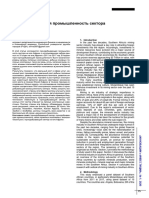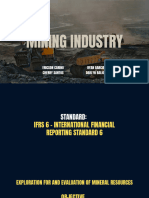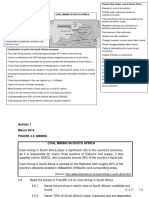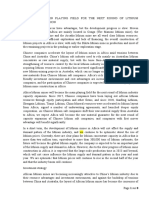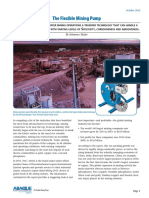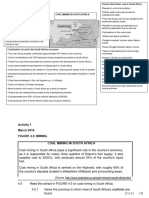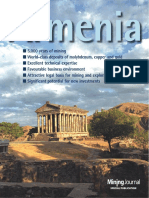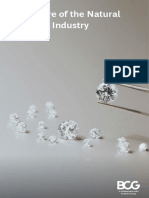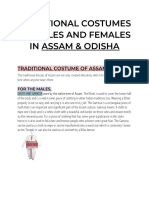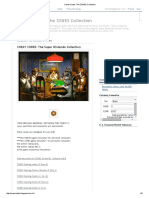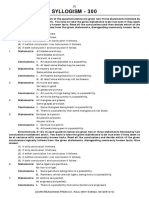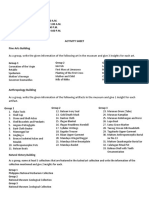2c Baxter Lbma2005
2c Baxter Lbma2005
Uploaded by
KamogeloGavanistroNtsokoCopyright:
Available Formats
2c Baxter Lbma2005
2c Baxter Lbma2005
Uploaded by
KamogeloGavanistroNtsokoOriginal Description:
Copyright
Available Formats
Share this document
Did you find this document useful?
Is this content inappropriate?
Copyright:
Available Formats
2c Baxter Lbma2005
2c Baxter Lbma2005
Uploaded by
KamogeloGavanistroNtsokoCopyright:
Available Formats
Mineral Beneficiation:
The Mining Industry Viewpoint
Roger Baxter
Chief Economist, Chamber of Mines of South Africa
Good morning to you all. I am going to have to do very much like the front
cover of the Alchemist and be like a cheetah and run very quickly through my
presentation. In order to do that, instead of being a traditional economist with two
hands to give you two different opinions, I am going to tie one hand behind my
back, so you only get half the story. In running through the story, I have produced
an article which Susanne Capano kindly put into the Alchemist on the subject,
so a lot more of the detail is there.
In chatting to some of my colleagues from offshore, when I talked about this
concept of beneficiation, there was a question: What is beneficiation? What are
you talking about? A lot of people offshore tend to see it very much more as a
manufacturing-driven type area. The mining industry in South Africa is very much
of the view that if we could add greater value to our minerals, then we should as a
country certainly facilitate that over time. Of course, the questions that need to be
answered in this whole equation are how to define beneficiation, what does it
mean, who the lead agents are who should be driving the process, and how do we
encourage beneficiation as we go forward.
The term beneficiation in South Africa does mineral products here we are talking about
elicit a lot of emotive response. Much of it is chemicals from coal, stainless steel, etc. it
based on the view that most products from South takes the export earnings of the minerals
Africa, based on the countrys previous colonial complex up to a level of greater than 50% of our
history and heritage, are exported to the previous merchandise exports.
colonial powers, where they are fabricated, and
then re-imported back into South Africa, and Confidential
that all the jobs in the processing side are then The contribution of primary minerals and primary
exported outside the country. plus intermediate beneficiated mineral products to
South Africa's merchandise exports, 2004
Much of the attention has been focused in recent 60
51
months on the mining sector and why the mining 50
% of merchandise exports
sector was allowing this to happen. We believe 40
that a lot of work has been done. Paul has done a 30
29.5
huge amount of work at Mintek looking at the
20
sidestream and downstream areas, and I think we
fully agree that there are very few advantages 10
that exist from having the precious metals 0
Primary minerals Primary and beneficiated minerals
produced inside South Africa; what we need to
do is look at a number of issues related to the 4
manufacturing sector.
Beneficiation defined is really the process of
Beneficiation is taking place in South Africa,
adding value from mining right through to the
where commercial opportunities do exist. About
final fabrication of a consumer branded product;
30% of our exports are minerals-driven; gold
the definition in the Minerals Policy White Paper
and platinum alone account for 20 percentage
captured it quite nicely. As you go through the
points of total exports. If you add beneficiated
different processes of minerals beneficiation, the
The LBMA Precious Metals Conference 2005, Johannesburg Page 25
Mineral Beneficiation: the Mining Industry Viewpoint Roger Baxter
mining and refining sides tend to be Confidential
concentrated on mining. In other words, the Global share of diamond mine production by value
mining sector has the skills and aptitude to tackle versus global share of diamonds cut and polished
by value, 2004
issues in that particular area. As soon as you get 60
into stages three and four, which are much more
% of world total
50
at the fabrication level, that is very much where 40
30
the manufacturing sector comes into the 20
equation. 10
0
rs
a
Confidential
l ia
a
ia
SA
l
la
a
a
C
sia
ae
ric
ad
di
an
he
go
ib
R
ra
iu
r
U
In
us
Af
am
D
an
lg
Is
ot
w
st
An
ts
Be
R
Au
h
C
&
N
Bo
ut
na
So
hi
THE FOUR STAGE BENEFICIATION PROCESS
,C
nd
la
ai
Th
Mine production by value Cut diamonds by value
Stage
M ineral b eneficiation Process flow-chart Labour Capital Industry
process category intensity intensity C lu ster 10
The action of mining and
W ashed &
producing an ore or
1 concentrate (primary
Run-of-m ine
ores
siz ed
High High Mini ng
conce ntrat es
product)
The action of converting a Mining Confidential
concentrate into a bulk Ma ttes/slags/
2 tonnage intermediate bulk
Ferro a lloys /
Low High Mini ng
product (such as a metal chemi ca ls
pure m etals
Gold, share of world mine production by volume
or alloy)
The action of converting the versus share of jewellery fabrication by volume
intermedia te goods into a
re fined produc t suitable for
W orked
Low High
Re fining / 2004
3 St eel/ alloys sha pes &
Manufa cturi ng
purc hase by both small &
sophisticated industries (se mis)
form s
Manu-
facturing 25
The action of
4 manufacturing a final
W orked
shapes &
W orke d
shapes & Medium to Me dium to Manufa cturi ng 20
% of world
form s form s high high
product for sale
15
10
6
5
0
ly
a
a
ey
lia
C eru
sia
i A pt
na
Sa E ia
M tan
Au SA
Pa AE
Tu a
IS
il
do a
az
ric
di
Ita
bi
In ad
s
ud gy
ra
rk
C
hi
ne
ay
In
U
U
kis
P
ra
Br
Af
an
st
C
al
h
It is very important to split the mining
ut
So
beneficiation equation with the mining Share of mine production volume Share of jewellery production
companies that have skills and competency away 11
from the manufacturing beneficiation area,
If you compare where the majority of production
which is where the manufacturing sector has the
happens with where the majority of cutting takes
skills and competency to deal with the issues.
place, for both diamonds and gold, most of the
The separation is very important because the miners are not necessarily into fabrication; the
debate has focused on why the mining fabrication is generally done in many other
companies have led to this lack of beneficiation countries India, Italy, Turkey, etc.
in the country. We are saying that beneficiation Confidential
is taking place where it is commercially feasible,
but the separation is quite important. Given the Platinum, global share of mine production by volume
versus global share of fabrication production by volume,
specialisation model that exists the Anglo- 80
2004
Saxon profit maximisation model companies 70
find it very difficult to go into areas where they 60
% of world total
do not have the competence and skills. 50
40
For precious metals and diamonds, the 30
20
availability of the product does not really 10
constitute an advantage. I think Paul has 0
South Russia Scrap North Others China and Japan Europe
answered the question in their view; from the Africa recovery America ROW
sides of Mintek and the government, maybe it Mine production by volume Beneficiation production by volume
does not. The vast majority of beneficiation 12
actually takes place in countries that do not mine
the product at all or do not mine much of the
product. What they have done is focused their The same thing is true for the platinum side. In
skill sets on the manufacturing sector. Here we South Africa, we produce about 15% of the
are talking about the Indias, the Chinas, the worlds catalytic converters. That is because of
Dubais, and even the Turkeys. They are focused the Motor Industry Development Plan (MIDP)
on the manufacturing side, because you can that was put into place by government, and
basically access the product at roughly the same where government and industry focused on what
price anywhere in the world. they needed to do to make the manufacturing
sector competitive in this particular area.
The LBMA Precious Metals Conference 2005, Johannesburg Page 26
Mineral Beneficiation: the Mining Industry Viewpoint Roger Baxter
Having established that the actual minerals 2.8% per year. In terms of manufacturing value
themselves do not constitute much of an added as a percentage of GDP, South Africas
advantage because you can get them basically manufacturing value added has actually dropped
at the same price anywhere in the world, I think in the period between 1992 and 2002.
the focus has shifted away from comparative Confidential
advantage having good natural beauty in your
Manufacturing value added as % of GDP at constant
landscape, natural tourist attractions, having the prices
minerals in the ground and being able to produce 35
them to having competitive advantage. Issues 30
such as competitive production, skills, etc., are
MVA as % of GDP
25
now the crucial drivers and determinants of 20
1992
where fabrication takes place. 15 2002
Competitive advantage issues in the 10
manufacturing sector are related to competitive 5
production, craftsmanship and the specific skills
0
a
SA
il
ia
nd
d
a
ia
lia
nd
az
ri c
re
n
an
ys
d
rk
ra
la
la
hi
U
that are required for jewellery fabrication, the
In
Br
Af
Ko
al
ala
Tu
Po
st
C
Ire
Ze
h
S-
Au
M
ut
ew
So
N
production of catalytic converters, or access to 17
markets. Invariably, the countries that have done
well on the fabrication side have had fairly large
domestic markets to start with. Other advantages A lot of work is being done; in fact, a new
include good market intelligence, knowing what industrial policy is currently being crafted by the
products you need to sell into which markets, Department of Trade and Industry. There are
having a low cost of doing business, and having pockets of success, like the motor industry,
low materials funding costs. In essence, there are which has grown quite nicely, but there also are
a lot of competitive advantage issues that need to pockets of failure. Overall, our manufacturing
be looked at. sector has not been performing to the extent that
it possibly could have. The reason I am
How competitive is our manufacturing sector in
highlighting this is because the manufacturing
South Africa? We have done a lot of work
sector is where we should be focusing our
through a number of different agencies looking
attention when it relates to the beneficiation
at how we have been doing in this particular
question. We are talking about manufacturing
area.
beneficiation here.
Confidential
Confidential
South Africa: Manufacturing as % of GDP
Real growth rate in manufacturing value added for the
22 period 1997 to 2002 (source UNIDO)
21.1 11
21 20.6 20.6 9.2
9 8.4 8.3
20
US$ value added
19.2 7
5.8
% of GDP
19 5.0
5 4.1 4.0 3.9 3.8
18 17.6 3 2.5 2.3 2.2
1.4
1.0
17 1
-1 -0.2
16
d
es
es
nd
ea
na
a
s
nd
il
ey
SA
lia
sia
an
ie
di
az
ric
tri
t ri
i
la
rk
la
or
tra
In
om
Ch
U
ay
al
Br
Af
un
un
I re
Po
Tu
K
Ze
us
al
S-
on
15
th
co
co
M
A
w
ou
ec
ng
d
Ne
pe
S
al
pi
1960's 1970's 1980's 1990's 2000's
on
lo
lo
ve
ve
i
sit
De
De
an
Tr
16
18
It is interesting to note that manufacturing has
Let us have a look at one issue related to
actually been declining as a percent of GDP.
productivity of labour as an issue that we have
The growth rates in productivity in South
been working on. There are a lot of legacies that
African manufacturing are not yet at the rates we
we are dealing with in South Africa, such as a
want. There has certainly been an improvement,
lack of attention to education and skills
but not quite at the level that we would want
development, and we have seen the LBMA
them to be. The growth rate in the manufacturing
supporting the Wits departments dealing with the
sector in South Africa has been fairly slow.
mining side in particular. In looking at our skills
Manufacturing has fallen off a bit. Services, side, it is interesting to note that a country like
tourism and financial services have grown at a New Zealand has a relative output of labour per
much faster pace, sitting at about 5% per year for dollar purchased less than ours; that is probably
the last decade. Manufacturing has grown at
The LBMA Precious Metals Conference 2005, Johannesburg Page 27
Mineral Beneficiation: the Mining Industry Viewpoint Roger Baxter
why they should stick to their sheep farming and This includes improving access to foreign
playing rugby. markets. I think our government has already
Confidential
done a fabulous job there through trade deals
with the European Union; there is a trade deal
Relative labour productivity as measured by value added
per US$1 labour purchased, 1999/2000 (source UNIDO)
being negotiated with the United States, and
6
certain trade deals are being discussed with
5
5.4 5.3
5.0
4.8 4.7
China and others.
Quantum leaping productivity is a big focus
US$ value added
4 3.7
3.3
3 2.5 2.4
amongst business, along with lowering the cost
2
2.0
1.7 of capital in the country in other words,
1 lowering tax rates over time. Access to inputs
0 at world competitive prices is a critical area.
Providing the right types of skills for such
d
nd
a
a
SA
a
ea
na
nd
il
an
di
ke
ric
si
az
la
la
or
hi
ay
In
al
r
Br
Af
Ire
Tu
Po
C
K
al
Ze
projects is important, signalled by this whole
S-
h
M
ut
ew
So
N
skills development drive. We must provide the
right logistical infrastructure, the right sort of
19
incentives for research and development, and we
In South Africas case, our relative output per must develop specific zones which are VAT free
unit of labour is such that we basically get about and duty free, as we have seen in a number of
$2 worth of value added for every dollar of other countries, which have been successful. I
labour that we purchase, but we are competing certainly believe that progress has been made.
against countries like India, where you are
Mining companies are trying their best to try to
getting about $3.70 of value added per dollar of
facilitate the process. On the materials funding
labour purchased; China, where you are getting
side, mining companies have been involved in
$4.70; and Ireland, although we are not really
gold loan schemes, and from a design and
competing with them in relation to jewellery
craftsmanship perspective, the platinum
fabrication. The point is that we do need to
company AngloPlats has funding the PlatAfrica
quantum leap our relative productivity levels,
competition and AngloGold Ashanti has funded
and a lot of emphasis is being placed on that
the Riches of Africa competition. We have seen
area.
the African gold zone being developed as a
We have been engaging with government, concept. The mining companies are trying their
Mintek and other role players on this matter. best to facilitate, but they do not guarantee the
Minerals beneficiation at the manufacturing ultimate outcome of whether beneficiation will
level is a pretty complex area, but we think that be successful. It is really about whether we can
rather than trying to force mining companies, or get the manufacturing sector to be quantum
trying to place pressure on mining companies to leaped on the productivity side and provide the
do something about this and we have seen two right enabling environment, which will
recent pieces of legislation, the Diamond determine whether South Africa can or cannot
Amendment Bill and the Precious Metals make inroads on the beneficiation side.
Amendment Bill that lean a little more towards
Thank you.
pressure on the mining companies we as a
country, including government, labour, and
business, should be focusing on providing that
environment which allows our manufacturing
sector to be massively competitive.
The LBMA Precious Metals Conference 2005, Johannesburg Page 28
You might also like
- Orezone Mining - Luiri Gold Project ProspectusDocument10 pagesOrezone Mining - Luiri Gold Project ProspectusNgenda MulondaNo ratings yet
- D. Tyson - Tales of Alhazred PDFDocument203 pagesD. Tyson - Tales of Alhazred PDFGuilherme BiancarelliNo ratings yet
- First Five Pages From Old Angel MidnightDocument7 pagesFirst Five Pages From Old Angel MidnightCity LightsNo ratings yet
- Tatler UK 04.2019Document166 pagesTatler UK 04.2019Lus AmelieNo ratings yet
- Minerals Council Emerging Miners - Desk Research Report 10062019Document2 pagesMinerals Council Emerging Miners - Desk Research Report 10062019leratoNo ratings yet
- Castings SA December 2020 PDFDocument52 pagesCastings SA December 2020 PDFXantos YulianNo ratings yet
- Deep Analysis of Opportunities, Challenges, and Solutions in African MiningDocument9 pagesDeep Analysis of Opportunities, Challenges, and Solutions in African MiningRotimi OwowaNo ratings yet
- Mining Sector Industry in Southern AfricaDocument5 pagesMining Sector Industry in Southern AfricasihleNo ratings yet
- MACIG-2016 Geology of AfricaDocument87 pagesMACIG-2016 Geology of AfricaNajidYasserNo ratings yet
- Market Primer Mine ProductionDocument7 pagesMarket Primer Mine ProductionSaket SNo ratings yet
- Minerals Investment StudyDocument195 pagesMinerals Investment StudyWaheed Ur Rehman100% (1)
- Iron Steel 2finalDocument22 pagesIron Steel 2finalrohithranjan2011No ratings yet
- Mercury-Free Extraction ProcessDocument2 pagesMercury-Free Extraction ProcessBernie_Garcia__9886100% (1)
- 2018 The Future of MiningDocument7 pages2018 The Future of MiningAlex Manuel Lemus MadridNo ratings yet
- 7 - Case Study - MoraesDocument24 pages7 - Case Study - MoraesGeorgi Mitkov SavovNo ratings yet
- Unlocking The Potential in Madagascar's Natural ResourcesDocument1 pageUnlocking The Potential in Madagascar's Natural Resourcesjulianme77No ratings yet
- Sustainable Mining in Africa: Standards As Essential CatalystsDocument55 pagesSustainable Mining in Africa: Standards As Essential CatalystsEnrique MartinezNo ratings yet
- Rca Fiche Industries Extractives v7Document10 pagesRca Fiche Industries Extractives v7erictakukamNo ratings yet
- 截屏 2022-12-17 07.22.46Document29 pages截屏 2022-12-17 07.22.46tobeyourgoodselfNo ratings yet
- Mining Facts and FiguresDocument1 pageMining Facts and FiguresAnatheaAcabanNo ratings yet
- Mining Industry 4Document37 pagesMining Industry 4tiaraacadscommisionerNo ratings yet
- Sami 2012Document216 pagesSami 2012sanda anaNo ratings yet
- 15 Mineral ResourcesDocument6 pages15 Mineral ResourcesMthobisi MhlongoNo ratings yet
- Interview Stanislas de Stabenrath - Managing Director X&M Suppliers - MAGIC 2017Document2 pagesInterview Stanislas de Stabenrath - Managing Director X&M Suppliers - MAGIC 2017Stanislas De StabenrathNo ratings yet
- Coal Mining in South AfricaDocument3 pagesCoal Mining in South AfricanetswerashonisaniNo ratings yet
- Consmurch Ar 06Document80 pagesConsmurch Ar 06Take OneNo ratings yet
- Mining-Industry 1Document37 pagesMining-Industry 19nh9xfrkqyNo ratings yet
- Transaction Highlights: Krugold Resources, IncDocument5 pagesTransaction Highlights: Krugold Resources, IncAamir AzizNo ratings yet
- The Main Playing Field For The Next Round of Lithium DevelopmentDocument8 pagesThe Main Playing Field For The Next Round of Lithium DevelopmentMichael NgoieNo ratings yet
- Paul Jourdan Up and Downstream Linkages in The Mineral Value ChainDocument51 pagesPaul Jourdan Up and Downstream Linkages in The Mineral Value ChainFaniyi Hussein KehindeNo ratings yet
- Abaque Whitepaper Peristaltic-in-Mining Oct12Document4 pagesAbaque Whitepaper Peristaltic-in-Mining Oct12GabrielNo ratings yet
- Coal Mining in South AfricaDocument4 pagesCoal Mining in South Africakoketsoshirley800No ratings yet
- Natural Marble Making - MinyaDocument46 pagesNatural Marble Making - Minyaharrisc0909No ratings yet
- Problems of Mining Industry BroshureDocument3 pagesProblems of Mining Industry Broshure66pbcjdrrfNo ratings yet
- 2016 Annual Report enDocument192 pages2016 Annual Report entirthaspaceNo ratings yet
- Mining and ToursDocument5 pagesMining and ToursJanella UmiehNo ratings yet
- In Eri The Indian Mining Industry NoexpDocument29 pagesIn Eri The Indian Mining Industry NoexpanshumanbaduNo ratings yet
- ArmeniaDocument12 pagesArmeniaHamed PiriNo ratings yet
- African Continental Free Trade Area Questions and AnswersDocument12 pagesAfrican Continental Free Trade Area Questions and AnswersThe Independent MagazineNo ratings yet
- Industry Career Guide: MiningDocument60 pagesIndustry Career Guide: MiningCORINNE FRANCES CRUZ100% (1)
- Minerals Council Facts and Figures Sep 2019 PDFDocument47 pagesMinerals Council Facts and Figures Sep 2019 PDFNuvya BabbarNo ratings yet
- fmf24 Official Event BrochureDocument17 pagesfmf24 Official Event BrochureSelim FenNo ratings yet
- Mining and The Law in AfricaDocument104 pagesMining and The Law in AfricaJoseph MatimbaNo ratings yet
- Sector Minero en El Perú - 2020 - BBVADocument63 pagesSector Minero en El Perú - 2020 - BBVAYensi Urbano CamonesNo ratings yet
- Metals and Mining November 2020Document43 pagesMetals and Mining November 2020aaNo ratings yet
- Africa Mining and Construction Jan-Mar 2024Document44 pagesAfrica Mining and Construction Jan-Mar 2024tafadzwachitongo0No ratings yet
- Part 4 - Market EnvironmentDocument25 pagesPart 4 - Market EnvironmentmelNo ratings yet
- World Silver Survey 2022Document86 pagesWorld Silver Survey 2022Anthony FloresNo ratings yet
- Chamber Facts Figures 2016Document44 pagesChamber Facts Figures 2016Vimal AnbalaganNo ratings yet
- Circum HCFDocument2 pagesCircum HCFtarunviconsNo ratings yet
- Africa Review Report On Mining: Economic and Social CouncilDocument20 pagesAfrica Review Report On Mining: Economic and Social CouncilblacknileNo ratings yet
- Manica Gold Project Mozambique: April 2018Document21 pagesManica Gold Project Mozambique: April 2018dclayjutaNo ratings yet
- Current Transformer, Potential Transformers, Transformer, Power Transformer, Distribution Transformer, VCB Panel. Indoor VCB Panel, Outdoor VCB Panel, MV Switchgear Panel, Transmission Line equipment, Overhead line equipmentsDocument55 pagesCurrent Transformer, Potential Transformers, Transformer, Power Transformer, Distribution Transformer, VCB Panel. Indoor VCB Panel, Outdoor VCB Panel, MV Switchgear Panel, Transmission Line equipment, Overhead line equipmentsSharafat AliNo ratings yet
- Geograghy Group 4 WorkDocument5 pagesGeograghy Group 4 Workdaniellanassuunakirabo99No ratings yet
- 1 s2.0 S0301420720309272 MainDocument14 pages1 s2.0 S0301420720309272 Mainjlgraffe6241No ratings yet
- BCG The Future of The Natural Diamond Industry MayDocument33 pagesBCG The Future of The Natural Diamond Industry MayArjun KumarNo ratings yet
- 0310 Delo It Te MiningDocument39 pages0310 Delo It Te MiningSandi S.V. BedoelNo ratings yet
- 1 s2.0 030142079290052B MainDocument14 pages1 s2.0 030142079290052B MainJoanna Paula BenitezNo ratings yet
- Industry Unit: Topic Key Points 1. Sectors of EmploymentDocument4 pagesIndustry Unit: Topic Key Points 1. Sectors of EmploymentAndy FunnellNo ratings yet
- BMO Mining & Metals Conference: The Next Multi-Jurisdictional West African Gold ProducerDocument14 pagesBMO Mining & Metals Conference: The Next Multi-Jurisdictional West African Gold ProducerkaiselkNo ratings yet
- Report - On - Nacosh - Ecc - Visits - Kakamega - 14.3.2024Document5 pagesReport - On - Nacosh - Ecc - Visits - Kakamega - 14.3.2024Iddi OmarNo ratings yet
- Fostering Technology Absorption in Southern African EnterprisesFrom EverandFostering Technology Absorption in Southern African EnterprisesNo ratings yet
- Strategies for Cotton in West and Central Africa: Enhancing Competitiveness in the 'Cotton-4'From EverandStrategies for Cotton in West and Central Africa: Enhancing Competitiveness in the 'Cotton-4'No ratings yet
- Physics 213 Problem 1 Week 3 Adiabatic Compression: SolutionDocument4 pagesPhysics 213 Problem 1 Week 3 Adiabatic Compression: SolutionKamogeloGavanistroNtsokoNo ratings yet
- Benef I Ciati OnDocument16 pagesBenef I Ciati OnKamogeloGavanistroNtsokoNo ratings yet
- Een2 Student Practical Guide 2015Document34 pagesEen2 Student Practical Guide 2015KamogeloGavanistroNtsokoNo ratings yet
- L. I. L. L.: SecttonDocument10 pagesL. I. L. L.: SecttonKamogeloGavanistroNtsokoNo ratings yet
- Chemical Met 2016 - Sem2Document4 pagesChemical Met 2016 - Sem2KamogeloGavanistroNtsokoNo ratings yet
- Cover Letter WritingDocument11 pagesCover Letter WritingKamogeloGavanistroNtsokoNo ratings yet
- Subjects: Assessment Method For All SubjectsDocument1 pageSubjects: Assessment Method For All SubjectsKamogeloGavanistroNtsokoNo ratings yet
- Course: Date of Experiment: Surname & Initials: Ntsoko KS Student Number: 214026244 GroupDocument14 pagesCourse: Date of Experiment: Surname & Initials: Ntsoko KS Student Number: 214026244 GroupKamogeloGavanistroNtsokoNo ratings yet
- Student No. Surname Initials Date Time Venue Coagulation & Flocculation Group 1Document4 pagesStudent No. Surname Initials Date Time Venue Coagulation & Flocculation Group 1KamogeloGavanistroNtsokoNo ratings yet
- Chemical Engineering: Timetable For First Semester 2016 - NDCE03 - Year 2 - S3Document2 pagesChemical Engineering: Timetable For First Semester 2016 - NDCE03 - Year 2 - S3KamogeloGavanistroNtsokoNo ratings yet
- CH 1 IntroductionDocument3 pagesCH 1 IntroductionKamogeloGavanistroNtsokoNo ratings yet
- Strip CladingDocument26 pagesStrip Cladingviswamanoj100% (1)
- Gospel of Shri Ram KrishnaDocument218 pagesGospel of Shri Ram Krishnaakash123\No ratings yet
- Powder Her FaceDocument22 pagesPowder Her FaceDan WilsonNo ratings yet
- Mairs The Archaeology of The Hellenistic Far East: A Survey. Update 1 2013.Document24 pagesMairs The Archaeology of The Hellenistic Far East: A Survey. Update 1 2013.hcarn2016No ratings yet
- Traditional Costume of Males and Females in Assam and OdishaDocument15 pagesTraditional Costume of Males and Females in Assam and OdishaSonia KeswaniNo ratings yet
- Cheat Codes - The ZSNES CollectionDocument9 pagesCheat Codes - The ZSNES Collectionh4nz0wNo ratings yet
- SyllogismDocument75 pagesSyllogismmehraishita42No ratings yet
- Cambridge Pet Vocabulary 1Document3 pagesCambridge Pet Vocabulary 1NarminNo ratings yet
- Chanthaburi, Heating Gems EtcDocument15 pagesChanthaburi, Heating Gems EtcomarfarookkhanNo ratings yet
- A Hundred Hands-Art WebsiteDocument116 pagesA Hundred Hands-Art WebsitelathadevaraajNo ratings yet
- Handbook of GemsDocument220 pagesHandbook of GemsParallaxster100% (3)
- Common Recruitment Process For Probationary Officers - Management Trainees in Participating Organisations - (CRP PO - MT - IX) PDFDocument2 pagesCommon Recruitment Process For Probationary Officers - Management Trainees in Participating Organisations - (CRP PO - MT - IX) PDFAshish Kumar DograNo ratings yet
- Syllogism 300 PDFDocument41 pagesSyllogism 300 PDFDeep Shikhar67% (3)
- Catalogue: The Collection ofDocument532 pagesCatalogue: The Collection ofDigital Library Numis (DLN)No ratings yet
- Catalouge PDF 2046 15811Document124 pagesCatalouge PDF 2046 15811iiamsyedumarNo ratings yet
- Module 3Document3 pagesModule 3Kristina Kalvaitytė StašaitienėNo ratings yet
- Tanis HQDocument16 pagesTanis HQSachin ArdeNo ratings yet
- SUADocument2 pagesSUAEpejema Tagarao Amaro100% (1)
- Free Crochet Pattern Tanya's Teardrop Earrings - Pattern ParadiseDocument1 pageFree Crochet Pattern Tanya's Teardrop Earrings - Pattern ParadiseSonalisa PramanikNo ratings yet
- Homophone: ExampleDocument15 pagesHomophone: ExampleKiro AkairoNo ratings yet
- Crypt of The Mad Alchemist - BookletDocument10 pagesCrypt of The Mad Alchemist - BookletLudovic Draiganix GrondinNo ratings yet
- Activity Sheet National MuseumDocument1 pageActivity Sheet National MuseumEljay FloresNo ratings yet
- Dragon Fireworks 2015 Factory Price Cheapest - Cas PDFDocument6 pagesDragon Fireworks 2015 Factory Price Cheapest - Cas PDFJoe AguilarNo ratings yet
- Marketing CommunicationDocument7 pagesMarketing CommunicationAbhiyan AdhikariNo ratings yet
- Running Death House NotesDocument7 pagesRunning Death House NotesDavid MartínezNo ratings yet
- The Complete Metalsmith: An Illustrated Handbook - Tim Mccreight - 1991Document4 pagesThe Complete Metalsmith: An Illustrated Handbook - Tim Mccreight - 1991amitleckNo ratings yet
- Collezioni Haute Couture Sposa Numero 165 2017Document385 pagesCollezioni Haute Couture Sposa Numero 165 2017Eirene FlorNo ratings yet







